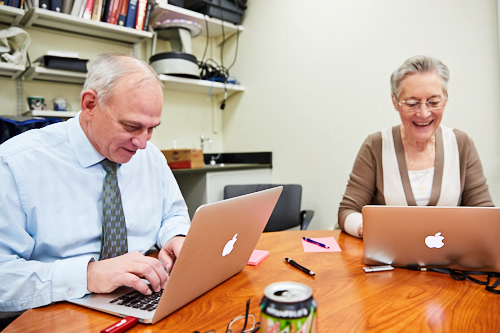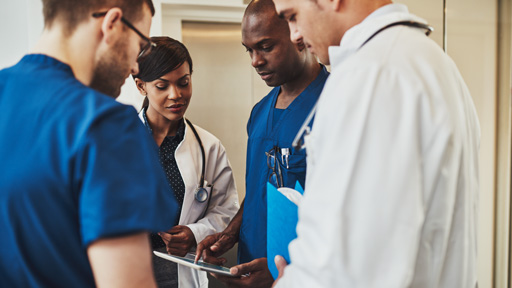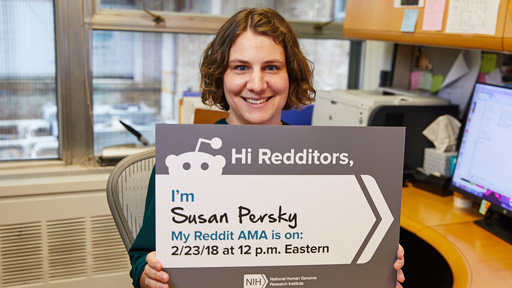Reddit AMA: The Undiagnosed Diseases Network
On March 3, 2017, in honor of Rare Disease Day, a day celebrated worldwide to raise awareness for rare diseases, experts from the UDN turned to Reddit - a social news website and discussion forum - to answer questions from the Reddit community as part of an "Ask Me Anything" (AMA).
Solving Medical Mysteries
Clinical and research experts from the Undiagnosed Diseases Network (UDN) have joined forces to solve the most challenging medical mysteries. Supported by the NIH Common Fund, UDN uses genome sequencing in the clinic, along with a network of experts, to provide answers for patients and families affected by mysterious conditions.
On March 3, 2017, in honor of Rare Disease Day, a day celebrated worldwide to raise awareness for rare diseases, experts from the UDN turned to Reddit - a social news website and discussion forum - to answer questions from the Reddit community as part of an "Ask Me Anything" (AMA).
Our AMA hosts were William Gahl, M.D., Ph.D., NHGRI's clinical director and head of the Undiagnosed Diseases Program (UDP), Cyndi Tifft, M.D., Ph.D., NHGRI's deputy clinical director and head of the pediatric portion of the UDP, and Mr. Chad Smith (aka "Chad the Dad"), father of Blake, an 8-year-old child with an undiagnosed disease whose symptoms are currently being researched by the UDN. Here, we recap the event (or you can check out Reddit Science's page to read the full "AMA!")

Overall, the team answered over thirty questions related to rare disease research, how the medical community can more accurately make diagnoses and how to find support when you or a loved one has a rare or undiagnosed condition. For example, Dr. Gahl told a story about a particularly challenging case and how sharing information with others in the medical community led to a diagnosis for this patient.
From Richara9:
What is an example of one of the more elusive diseases you've diagnosed?
Why did it take so long to determine? How is this compared to your average "turn-around" time?
From Undiagnosed_Diseases:
We had a 22-year-old woman with dystonia, an abnormal and involuntary contraction of muscles. In her case, it involved the tongue, and she was unable to eat so she needed a feeding tube. We were stumped, but put her genetic information on a website, along with a brief description of her symptoms, in a de-identified fashion. Well, a neurologist in London called me up and told me she had 19 patients with a variant in the gene we suspected in our patient! So, we had a diagnosis after 2-3 years. And not only that, but the paper describing this new disease is now published, and there appears to be a treatment: deep brain stimulation. Our average turn-around time is only slightly faster, and reflects the fact that we more often make a diagnosis of a known, rare disease. - William Gahl
Having a child with a rare and undiagnosed condition is often scary and frustrating for parents. The Reddit community was curious to hear Chad's experiences in working with the UDN, as well as the academic path to take for students with an interest in studying rare diseases.
From supergyration:
Thank you all for doing this AMA! Chad the Dad: How has it felt as a parent as your son is dealing with something doctors are unable to diagnose? How did you hear about UDN, and were you apprehensive at all about bringing Blake there?
Dr. Gahl and Dr. Tifft: What kind of academic path would you suggest for college students who want to be involved in this type of work as a career goal?
From Undiagnosed_Diseases:
Throughout our medical journey many doctors, nurses and medical facilities have done what I have termed, "Tapping Out." Tapping out is when medical professionals express their limitations and tell us there is nothing more they can do for our son. We respect people when they share their limits, but mourn the loss of yet another possible avenue for help. Ultimately, we started asking where else can we go and who else can help provide answers. We were told about the NIH, an undiagnosed program at Duke University and the UDP. So, I hit the internet and began looking into these options. The UDN has promised to never "Tap Out" and never give up. For this we are eternally grateful and know that our son is well worth the research. We don't know what the future has in store for Blake; what he can achieve, and where life will take him. Unfortunately, he is still undiagnosed. But, we take great comfort in the knowledge that, not only are the UDN and its associates working to finding a diagnosis/cure/treatment for Blake, but that Blake will provide answers for children with rare neuromuscular conditions. - Chad the Dad
From Undiagnosed_Diseases:
The path to becoming a physician scientist is a long one. If you have the "fire in your belly" to pursue this path, score well in your undergraduate science classes. Use summers for volunteering or working in a research lab or volunteering in a clinical setting. Medical schools are usually looking for top students who are also well-rounded in other parts of their lives. If you are seeking an M.D., Ph.D. as many physician-scientists are, you will need some introductory research background to optimize your chances. With your medical degree, you then have many specialty paths to care for patients with rare diseases: pediatrics, internal medicine and genetics. Good luck, and enjoy the journey!! - Cyndi Tifft
From Undiagnosed_Diseases:
Well, I certainly agree with Dr. Tifft; I have to, since she sits right next to me. I would say that to be a leader in this area, you need an advanced degree, i.e., either an M.D. or Ph.D. But that is only the start. If an M.D., you should choose a specialty amenable to rare disease research, e.g., pediatrics, and then a fellowship, likely in genetics. If a Ph.D., you should get a great background during graduate school, and then do a post-doctoral fellowship in a lab that studies pathways or cell biology, currently or potentially related to a human disease. - William Gahl
The Reddit community was also interested in what happens when the UDN takes on a new patient and how many people are involved to make it as successful as it has been.
From ThisWanderer:
At what level are you looking at the diseases? Metabolomic, transcriptomic, single cell?
How do you decide where to start given the dearth of information on these diseases?
How big is your team?
From Undiagnosed_Diseases:
Actually, all of the above and more! First we gather all the medical records for review, invite the patient to the NIH for a one-week inpatient evaluation tailored to their symptoms and findings and based on what we find we proceed with genetic and metabolic testing. This often involves genome or exome sequencing to identify candidate genes that may be causing the patient's disease. Based on the genes and mutations we identify, we move on to transcriptome, metabolome, or making model organisms with the mutation in question. The team at the NIH includes about 20 people but we have about 50 physician consultants who offer their services to evaluate our patients and also provide valuable insights. The UDN is much larger and involves 7 clinical sites, two sequencing centers, a metabolomics core, a model organisms core, a biorepository, and a coordinating center. There were more than 100 people sitting around the table at the last steering committee meeting and that did not include many folks back home. - Cyndi Tifft
Lastly, the team received questions from the medical community about how to improve diagnoses for rare diseases, and how to deal with the costly endeavor of over-testing certain patients.
From ThisWanderer:
To add on to this question, as a doctor, where do you strike the balance between seeking out an etiology for a potentially rare disease and over-testing?
As a hospitalist, I find it difficult to send people home with no answer but also am aware of the cost missed days of work, hospital stays, lab tests, and the risk of injury from hunting for a disease.
Also, what are some good resources for me to improve my differential diagnosis of rare diseases?
From Undiagnosed_Diseases:
In an era of increasing health care costs, you pose a very important dilemma. We are more likely to accept patients into the UDP/UDN if they have at least one objective finding to their illness; for example an abnormal lab value, biopsy or radiographic study. If the common things have been ruled out we move to a more comprehensive look over a very short period, say a week of intense evaluation with multiple consultants, labs, and radiographic studies. We gather the consultants together "real time" to talk about the case and work with each other in making a differential diagnosis. If none of the testing has given a definitive answer, then we move to exome or genome sequencing. This short-circuits that "doctor shopping" over a prolonged period...like seeing multiple neurologists with the same complaint and have them run the same testing, each in their own institution. Resources for you as a physician thinking about rare diseases might be: (1) The Metabolic and Molecular Bases of Inherited Disease (a four volume textbook that is on line). The table of contents makes a nice algorithm for differential diagnosis (2) Online Mendelian Inheritance in Man (www.omim.org) is a cataloging of Mendelian disorders and can be searched by symptom or phenotype (3) SimulConsult (http://www.simulconsult.com/) is another resource to search based on symptomatology. (4) Lastly, if you know the rare diagnosis and need comprehensive peer-reviewed information on differentials and management would be GeneReviews (https://www.ncbi.nlm.nih.gov/books/NBK1116/). Good luck studying, call with questions! - Cyndi Tifft
Related Content
Last updated: March 8, 2017



